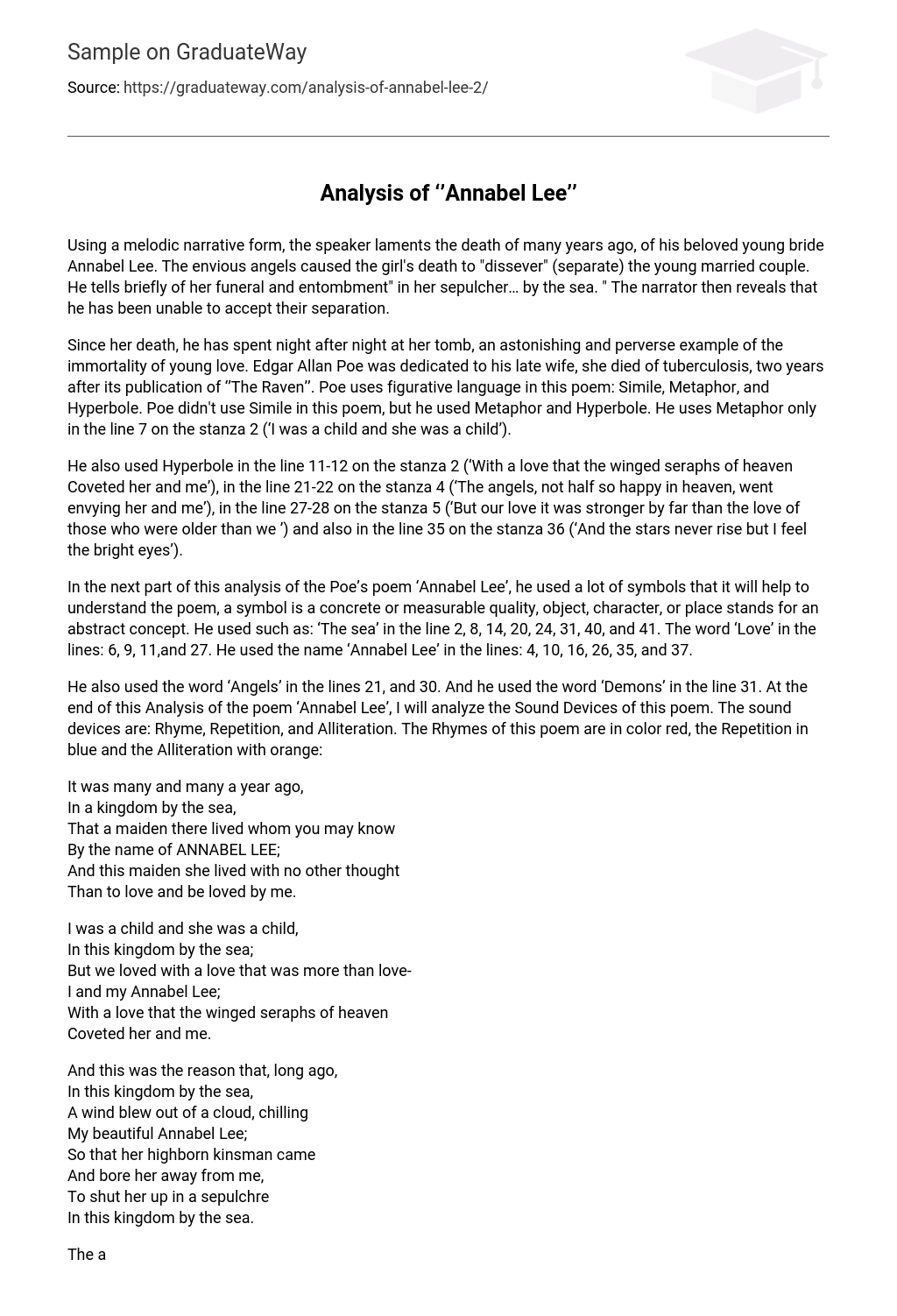Embracing a melodic narrative structure, the speaker grieves over the passing of his cherished young bride, Annabel Lee, which occurred many years ago. The girl’s untimely demise was caused by envious angels who deliberately separated the couple. The speaker briefly recounts the funeral and burial of his beloved “by the sea” in her sepulcher. Ultimately, the narrator conveys his ongoing inability to accept their heartbreaking separation.
Ever since her death, he has spent countless nights at her tomb, a remarkable and twisted testament to the boundlessness of young love. Edgar Allan Poe had a profound devotion to his deceased wife, who passed away from tuberculosis just two years after the publication of his poem “The Raven.” In this particular piece, Poe employs various forms of figurative language including simile, metaphor, and hyperbole. However, it is important to note that simile is absent in this specific poem. Nevertheless, Poe incorporates metaphor and hyperbole throughout the verses. One instance of metaphor can be found in line 7 of stanza 2, where he declares “I was a child and she was a child.”
Hyperbole is utilized by the author in several instances throughout the poem. In stanza 2, he employs it in lines 11-12 (‘With a love that the winged seraphs of heaven Coveted her and me’). Stating that the love they shared was coveted by heavenly beings emphasizes its exceptional nature. Similarly, in stanza 4, lines 21-22 (‘The angels, not half so happy in heaven, went envying her and me’), he exaggerates the envy experienced by angels as they witness their happiness. In stanza 5, lines 27-28 (‘But our love it was stronger by far than the love of those who were older than we’), the author magnifies the strength of their love compared to others. Lastly, in stanza 36, line 35 (‘And the stars never rise but I feel the bright eyes’), the author exaggerates the impact of their beloved’s presence to convey their constant awareness.
In this analysis of Edgar Allan Poe’s poem ‘Annabel Lee’, he incorporates several symbols that aid in understanding the poem. A symbol is a tangible or measurable quality, object, character, or place that represents an abstract concept. These symbols include ‘The sea’, which appears in lines 2, 8, 14, 20, 24, 31, 40, and 41. The word ‘Love’ is utilized in lines 6, 9, 11, and 27. Additionally, the name ‘Annabel Lee’ is mentioned in lines 4, 10, 16, 26, 35, and 37.
In lines 21 and 30, he also referred to ‘Angels’. Additionally, he mentioned ‘Demons’ in line 31. To conclude this Analysis of the poem ‘Annabel Lee’, the Sound Devices used in the poem will be analyzed. These Sound Devices include Rhyme, Repetition, and Alliteration. Rhymes are highlighted in red, Repetition in blue, and Alliteration in orange:
Many years ago, in a kingdom beside the sea, there lived a maiden named ANNABEL LEE. Her only desire was to love and be loved by me.
I was a child and she was a child,
In this kingdom by the sea;
But we loved with a love that was more than love-
I and my Annabel Lee;
With a love that the winged seraphs of heaven
Coveted her and me.
Long ago, a wind blew out of a cloud, chilling my beautiful Annabel Lee in this kingdom by the sea. Her highborn kinsman came and bore her away from me to shut her up in a sepulchre in this kingdom by the sea.
The angels in heaven were not as happy as they were envying her and me. Yes, that was the reason, as all men know in this kingdom by the sea, that the wind came out of the cloud by night, chilling and killing my Annabel Lee.
But our love was stronger than the love of those older than us, of many wiser than us. Neither the angels in heaven above nor the demons down under the sea can ever dissever my soul from the soul of the beautiful Annabel Lee.
For the moon always brings me dreams of the beautiful Annabel Lee;
And the stars always rise, making me feel the radiant eyes of the beautiful Annabel Lee;
And so, all night long, I lie by the side of my beloved – my life and my bride, in the tomb by the sea, by the sounding sea.
Concluding this analysis of Edgar Allan Poe’s poem ‘Annabel Lee’, we can understand the poem and the author’s intended message. We now comprehend the use of Figurative Language, Symbols, and Sound Devices in the poem. Personally, I enjoy this poem due to the author’s skillful employment of Rhymes and Symbols, although there is one aspect I do not appreciate – its focus on the unloved. I prefer happiness and love. In conclusion, it is a good poem.





